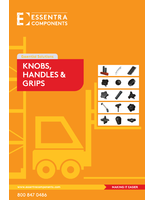Milling Grades suit finishing/roughing applications.
Press Release Summary:

Grades KC915M and KC935M, suited for milling applications, have one layer of medium temperature chemical vapor deposition titanium carbonitride, one layer of fine-grain alpha structure aluminum oxide, and graded interface layers that increase adhesion between layers. KC915M is suited for semifinishing to roughing of cast iron and ductile irons, while KC935M is for general purpose machining and heavy roughing of carbon, alloy, and stainless steels as well as ductile irons.
Original Press Release:
Kennametal's New First-Line Milling Grades Offer Performance Gains
(Latrobe, PA; March 28, 2003) -- Kennametal's new first-line milling grades, KC915M and KC935M, offer substantial performance gains in a wide range of milling applications. KC915M is designed for semifinishing to roughing of cast iron and ductile irons. KC935M is for general purpose machining and heavy roughing of carbon steels, alloy steels, stainless steels, and ductile irons. Both grades take advantage of recent Kennametal advances in coating technology to run 30% longer than the grades they replace. "In testing these grades against a wide range of competitive materials, they have demonstrated the ability to consistently outperform competitive grades as well as our earlier materials," said Nick Gaten, Milling Product Manager for Kennametal.
Both of these new grades incorporate improvements in coating technology that have already helped Kennametal's new KC9125 and KC9110 steel turning grades achieve the fastest sales growth in the company's history. Starting from the substrate and moving outward, both new grades have a layer of medium temperature chemical vapor deposition (MTCVD) titanium carbonitride (TiCN) and a layer of fine-grain alpha structure aluminum oxide (Al2O3). The new inserts also incorporate graded interface layers that increase the adhesion between coating layers.
"The problem with the older kappa structure aluminum is that it has a tendency to change into the alpha phase at higher temperatures and flake off," said Tim Marshall, Milling Product Manager for Kennametal. "The alpha style aluminum oxide used in these new grades, on the other hand, maintains its stability at much higher temperatures." The MTCVD TiCN coating also provides a significant advantage by eliminating the tendency found in higher-temperature CVD TiCN coatings to form an eta phase that can reduce the transverse rupture strength of the insert. In addition, microfinishing of the cutting edge reduces surface roughness, minimizing the possibility of built-up edge.
Kennametal recommends running KC915M in grey cast iron without coolant at 750 surface feet per minute (sfm) to 1400 sfm or with coolant at 500 sfm to 900 sfm. On ductile irons, the company recommends running at 500 sfm to 900 sfm without coolant. Recommended cutting conditions for KC935M, on the other hand, are 600 sfm to 1000 sfm on carbon steel, 400 sfm to 800 sfm on alloy steel, 450 sfm to 700 sfm on 200 and 300 series stainless steel, and 450 sfm to 800 sfm on 400 series stainless steel. Gaten notes that KC935M also works well in heavy roughing operations on ductile irons at 350 sfm to 600 sfm.
Both grades are available in styles and sizes to fit Kennametal's major milling platforms, KSSM, NGE, and FixPerfect, as well as ANSI-ISO styles. KSSM cutters provide higher positive rake angles versus competitive cutters for longer tool life and lower horsepower consumption. NGE indexable insert end mills offer the highest possible metal removal rates in a variety of difficult-to-machine materials.
For more information about Kennametal metalcutting products, please call 800-446-7738 or visit www.kennametal.com.




